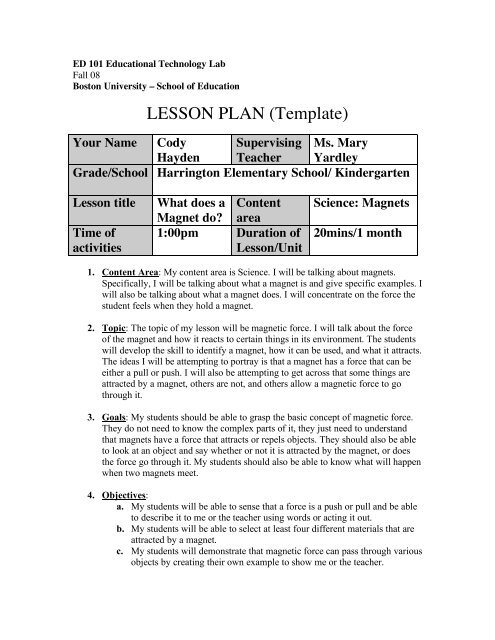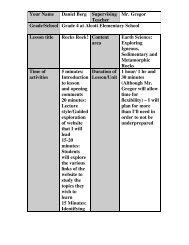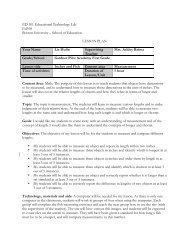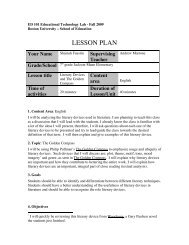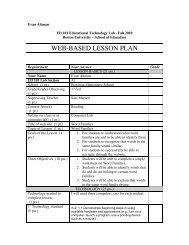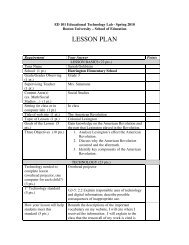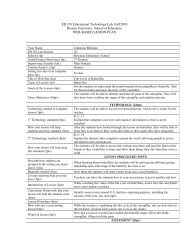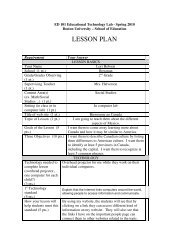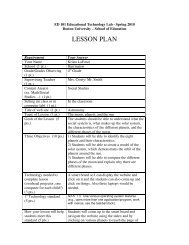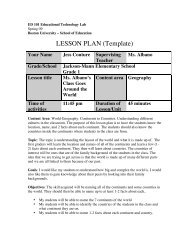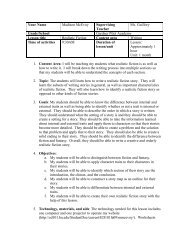LESSON PLAN (Template) - ED101 - Boston University
LESSON PLAN (Template) - ED101 - Boston University
LESSON PLAN (Template) - ED101 - Boston University
You also want an ePaper? Increase the reach of your titles
YUMPU automatically turns print PDFs into web optimized ePapers that Google loves.
ED 101 Educational Technology Lab<br />
Fall 08<br />
<strong>Boston</strong> <strong>University</strong> – School of Education<br />
<strong>LESSON</strong> <strong>PLAN</strong> (<strong>Template</strong>)<br />
Your Name Cody<br />
Hayden<br />
Supervising<br />
Teacher<br />
Ms. Mary<br />
Yardley<br />
Grade/School Harrington Elementary School/ Kindergarten<br />
Lesson title<br />
Time of<br />
activities<br />
What does a<br />
Magnet do?<br />
1:00pm<br />
Content<br />
area<br />
Duration of<br />
Lesson/Unit<br />
Science: Magnets<br />
20mins/1 month<br />
1. Content Area: My content area is Science. I will be talking about magnets.<br />
Specifically, I will be talking about what a magnet is and give specific examples. I<br />
will also be talking about what a magnet does. I will concentrate on the force the<br />
student feels when they hold a magnet.<br />
2. Topic: The topic of my lesson will be magnetic force. I will talk about the force<br />
of the magnet and how it reacts to certain things in its environment. The students<br />
will develop the skill to identify a magnet, how it can be used, and what it attracts.<br />
The ideas I will be attempting to portray is that a magnet has a force that can be<br />
either a pull or push. I will also be attempting to get across that some things are<br />
attracted by a magnet, others are not, and others allow a magnetic force to go<br />
through it.<br />
3. Goals: My students should be able to grasp the basic concept of magnetic force.<br />
They do not need to know the complex parts of it, they just need to understand<br />
that magnets have a force that attracts or repels objects. They should also be able<br />
to look at an object and say whether or not it is attracted by the magnet, or does<br />
the force go through it. My students should also be able to know what will happen<br />
when two magnets meet.<br />
4. Objectives:<br />
a. My students will be able to sense that a force is a push or pull and be able<br />
to describe it to me or the teacher using words or acting it out.<br />
b. My students will be able to select at least four different materials that are<br />
attracted by a magnet.<br />
c. My students will demonstrate that magnetic force can pass through various<br />
objects by creating their own example to show me or the teacher.
d. My students will demonstrate that the ends of magnets sometimes attract<br />
each other and repel each other by using two magnets and showing me or<br />
the teacher.<br />
e. My students will be able to realize what magnets can be used for in their<br />
school, home, and in the “grown-up” world and demonstrate this by<br />
bringing in a magnet to school and describing what it does outside of the<br />
classroom. This “grown-up” world is how magnets are used in jobs around<br />
the world.<br />
f. My students will be able to give two or more example of something that is<br />
a magnet even if it does not look like a typical magnet. For example, they<br />
will be able to realize that the letters that stick to their refrigerators have<br />
magnets on the back.<br />
g. My students will learn how to go back on the website to learn more about<br />
magnets and show their parents what they learned in school.<br />
5. Technology, Materials, and Aides: I will need one computer that is hooked up to<br />
some sort of projector. Then I would need a screen, Smartboard, or whiteboard to<br />
project the website onto. I would then need some magnets. The magnets will<br />
consist of two bar magnets, a plain black magnet, a refrigerator magnet, and two<br />
or three objects with a magnet on the back that do not look like typical magnets. I<br />
will also have similar things that are not magnets so the students can recognize<br />
what makes something a magnet. I will need objects that are attracted by magnets<br />
and ones that are not attracted by magnets. These will consist of nails, other<br />
magnets, a metal cup, a metal washer, and paper clips. I will also have things that<br />
are not attracted by magnets. These things will be paper, cloth, and a plastic water<br />
bottle. Some of these objects can be collected from the students prior to the<br />
lesson. For example, the students would be asked to bring in one thing they think<br />
can be picked up from a magnet and one thing that cannot be picked up by a<br />
magnet. These will then be discussed with the class as part of the lesson.<br />
6. Procedures/Methods:<br />
a. Overview: The lesson is basically going to be a back and forth discussion<br />
between the students and myself. I will be using the website as a<br />
slideshow for the lesson. I will show one of the pages and then explain<br />
what the page says to the students. Then I will do a “hands-onexperiment”<br />
with the students so they can understand the concept of what<br />
the slide is telling them.<br />
b. Introduction: My lesson will begin with a quick survey of the class to see<br />
what they know about magnets. The students will know what a refrigerator<br />
magnet is and they will be more than happy to tell me. I will explain to<br />
them that there are many different kinds of magnets and that they do<br />
different things. This will get the discussion started and lay the<br />
groundwork for the rest of the lesson.<br />
c. Activities:<br />
i. First slide: “What is a Magnet?” This slide will describe what a<br />
magnet is and what it does.
1. I will then show the students a magnet and explain to them<br />
what a magnet is. I will give them a quick mention of the<br />
magnetic force but not in too much detail just yet. I will<br />
then take a magnet and show that it can attach itself to the<br />
whiteboard.<br />
ii. Second Slide: “What Am I Feeling?” This slide will describe that<br />
when you hold a magnet you will feel a “mysterious” force.<br />
1. I will then have two magnets which I will ask a student to<br />
come up and assist me with. The student and I will try to<br />
put the magnet together only to feel that it will not let us<br />
because it is pushing the two magnets apart. This will<br />
illustrate the pushing power of the magnets.<br />
2. Then I will ask another student to come up and help me<br />
with trying to put a magnet on the whiteboard. I will ask<br />
the student to stand up at the whiteboard with the magnet<br />
and hold it away from the whiteboard a little bit. I will then<br />
ask the student if he/she feels anything. The student should<br />
describe a pulling feeling. I will then ask the student to let<br />
go. When the student lets go, the magnet should attach<br />
itself to the whiteboard. This illustrates the pulling force of<br />
the magnet.<br />
iii. Third Slide: “What Does A Magnet Pick Up?” This slide will<br />
explain that a magnet will attract or repel certain objects.<br />
1. I will show the students some objects and ask them which<br />
ones they think will be picked up by the magnet. I will then<br />
try to pick up each object one at a time. The students will<br />
tell me what happens as I bring the magnet close to the<br />
object. If the object is picked up, I will explain that it is<br />
attracted by the magnet. If not, I will explain that it is not<br />
attracted by the magnet.<br />
2. Then I will ask the students if they can find anything in<br />
common among the objects attracted by the magnet. They<br />
will discover that they are all made of metal and the objects<br />
that were not attracted were not metal.<br />
iv. Fourth Slide: “Does Magnetic Force Go Through Anything?” This<br />
slide will explain that sometimes the magnetic force goes through<br />
something.<br />
1. I will then show how a magnet can go through objects. I will first<br />
demonstrate that a piece of paper cannot stick to the whiteboard on<br />
its own. Then I will pick up a magnet and the piece of paper,<br />
asking the students whether they think that the piece of paper will<br />
stay on the blackboard because of the magnet. Then I will let go of
the magnet allowing it to stick the paper to the whiteboard. This<br />
shows that magnetic force can go through objects.<br />
v. Fifth Slide: “What Happens When Magnets Come Together?” This<br />
slide will explain that magnets attract and repel at different ends.<br />
1. I will have two bar magnets that I will ask a student to help<br />
me put the ends together. We will at first try and put the<br />
magnets together with the same poles facing each other.<br />
The magnets will not attract each other, but instead repel<br />
each other. I will then ask the class what they think I should<br />
do with the magnets in order to get them to attract each<br />
other. Eventually, I will show them that when the poles are<br />
opposite the magnets will attract. This will show students<br />
that sometimes the ends of a magnet attract each other and<br />
sometimes they repel each other.<br />
vi. Sixth Slide: “What Are Magnets Used For?” This slide will<br />
describe the wide world of magnets from refrigerator magnets, to<br />
physics magnets, to big magnets used for construction.<br />
1. I will first explain to the students that magnets can be used<br />
for a lot of things in the world. I will explain to them the<br />
pictures they see on the website. For example, I will<br />
explain to the students that the magnet used in construction<br />
is very strong and is used to pick up big pieces of metal.<br />
Another example is that a compass has a magnet in it that<br />
points north.<br />
2. I will also have various other magnets that do not look<br />
exactly like magnets. I will show the students what the<br />
magnets can be used for in school and their house. These<br />
will be like the magnets they find on their building toys, or<br />
magnets with clips on them, or magnets that connect toy<br />
trains.<br />
d. Follow-up: The students will be given a very simple homework<br />
assignment. The students will be asked to go home and look for some<br />
magnets they have found in their house. They will then be asked to bring<br />
them in. The will also be asked to bring in objects that they think will be<br />
attracted by a magnet, or will have the magnetic force passed through it.<br />
Then the class will go over why they brought in what they did,<br />
concentrating on why something is a magnet or why an object is attracted<br />
by a magnet.<br />
7. Technology Frameworks:<br />
1.7) Collaborate with classmates to use teacher-selected Web sites.<br />
2.1) Follow classroom rules for responsible use of computers.
• The rules will be discussed with the students prior to the lesson. Then I<br />
will often refer to the rules while using my website so they can remember<br />
them better and in context.<br />
2.2) Develop understanding of the school’s rules for safe and ethical Internet use.<br />
(Use of Internet in this gradespan is under close supervision and determined by<br />
district policy.)<br />
• This will be discussed before the use of the website so students understand<br />
the dangers that the Internet could have.<br />
2.4) Develop understanding of how the computer is a tool for learning.<br />
8. Assessment Objectives:<br />
a. My students will be able to sense that a force is a push or pull and be able<br />
to describe it to me or the teacher using words or acting it out.<br />
b. My students will be able to select at least four different materials that are<br />
attracted by a magnet.<br />
c. My students will demonstrate that magnetic force can pass through various<br />
objects by creating their own example to show me or the teacher.<br />
d. My students will demonstrate that the ends of magnets sometimes attract<br />
each other and repel each other by using two magnets and showing me or<br />
the teacher.<br />
e. My students will be able to realize what magnets can be used for in their<br />
school, home, and in the “grown-up” world and demonstrate this by<br />
bringing in a magnet to school and describing what it does outside of the<br />
classroom. This “grown-up” world is how magnets are used in jobs around<br />
the world.<br />
f. My students will be able to give two or more example of something that is<br />
a magnet even if it does not look like a typical magnet. For example, they<br />
will be able to realize that the letters that stick to their refrigerators have<br />
magnets on the back.<br />
g. My students will learn how to go back on the website to learn more about<br />
magnets and show their parents what they learned in school.<br />
The majority of my questions are going to be knowledge based because of the<br />
difficulty of the subject and the age of my students. Magnetism is a difficult<br />
concept to really understand as a Kindergartener so asking them to answer<br />
knowledge based questions seems suitable. I do, however, want them to try to<br />
answer a few application questions. These would not be very difficult questions<br />
and would mostly consist of being able to pick out objects that are either magnets<br />
or are attracted by a magnet. These questions will also have pictures associated<br />
with them so that students will understand exactly what is being asked of them<br />
and will also jog their memory if they forgot a small part of the information.<br />
a. Multiple Choice Questions:<br />
1. What does a magnet do? *Picture of a Magnet*<br />
a. A magnet picks up wooden objects.
. A magnet picks up things made out of paper.<br />
c. A magnet picks up metal things.<br />
d. A magnet picks up food.<br />
(This will be assessing the second objective, which describes that a student will be able to<br />
select the materials a magnet attracts)<br />
2. Which object can a magnet pick up?<br />
a. (Picture of a metal washer) Metal Washers<br />
b. (Picture of a candy bar) A Candy Bar<br />
c. (Picture of a book) A Book<br />
d. (Picture of a cup) A Cup<br />
(This will be assessing the second objective, which describes that a student will be able to<br />
select the materials a magnet attracts)<br />
3. What is it called when you feel a pull between two magnets and then<br />
they stick together? *Picture of two magnets stuck together*<br />
a. It is called Repulsion.<br />
b. It is called Friction.<br />
c. It is called Dragging.<br />
d. It is called Attraction.<br />
(This will be assessing the first and fourth objectives, which describe that a student<br />
should be able to sense that a force is a push or pull and that this happens when two<br />
magnets come in contact with each other.)<br />
4. *Picture of two magnets that have the same poles facing each other*<br />
What do you feel when these two magnets come close to each other?<br />
a. It is really easy to push them together. In fact, they actually<br />
connect on their own. This is called Attraction.<br />
b. It is hard to push them together. Even when I get them really<br />
close they move away from each other. This is called Repulsion.<br />
(This will be assessing the first and fourth objective, which describe that, a student should<br />
be able to sense that a force is a push or pull and that this happens when two magnets<br />
come in contact with each other.)<br />
5. Can a magnet attach through something through other things like<br />
paper? *Picture of Refrigerator Magnet*<br />
a. Yes, a magnet can attract objects through something like paper.<br />
b. No, a magnet cannot attract something through an object.<br />
(This will be assessing the third objective, which describes that a student should be able<br />
to understand that a magnetic force can go through various objects.)
. Other Questions:<br />
1. What are some other objects that are magnets but do not look like<br />
magnets? Where are these objects found?<br />
(This will be assessing the fifth and sixth objective which describes that students should<br />
be able to understand that magnets can be found everywhere in the world and might not<br />
look like a regular magnet.)<br />
Answer Key<br />
a. Multiple Choice:<br />
1. C<br />
2. A<br />
3. D<br />
4. B<br />
5. A<br />
b. Other Questions: (Which objectives?)<br />
1. The answers for this question do not have to be complex. This is the<br />
type of question that is really the closest thing to application a<br />
Kindergartener can get to. The students can say things like a<br />
refrigerator magnet, a magnet used in a junk yard, the magnet in the<br />
special paper clip holders, or even the magnet on their toy cars. The<br />
places they choose can also be very vague, such as my home, school,<br />
junk yard, or my mom/dad’s work. The concept of this question is to<br />
get students to realize that magnets are everywhere and can be a part<br />
of anything.


